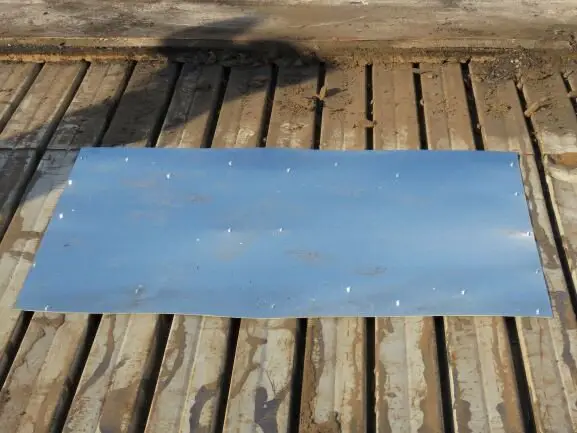Sheet Steel: Gauge, Thickness, and Weight Chart
By Jack Gray, Roof Online Editor • Last updated August 6, 2024
Table of Contents
- About These Sheet Steel Weights
- Table: Sheet Steel Weights and Thicknesses
- Manufacturers’ Standard Gauge for Sheet Steel
- Galvanized Sheet Steel Weight and Thickness
- Corrugated Sheet Steel Weight
- Sheet Steel Gauge Measuring Tool
- What is Gauge when Talking about Sheet Steel?
- Related Articles

About These Sheet Steel Weights
The values provided in the table are standards; real-life products will vary.
These values should not be used if extreme precision is needed for critical engineering calculations. When such precision is required, always refer to the data sheets of the actual, specific product you intend to use, or better yet, contact the technical department of the product manufacturer.
Manufacturer technical data sheets (with the sheet steel weights and thicknesses) are almost always made available on the websites of reputable manufacturers.
Table: Sheet Steel Weights and Thicknesses
| Thickness and Weight of Sheet Steel by Gauge | |||||
|---|---|---|---|---|---|
| Gauge | Thickness: Manufacturers’ Standard Gauge (Decimal Inches) |
Weight: Pounds per Square Foot (lb/ft2) |
Thickness: Manufacturer’s Standard Gauge (Millimeters) |
Weight: Kilograms per Square Meter (kg/m2) |
Examples of Use |
| Add 0.00375 for Galvanized Steel |
Add 0.156 for Galvanized Steel | Add 0.095 for Galvanized Steel | Add 0.762 for Galvanized Steel | ||
| 3 | 0.2391 inch |
10 lb/ft2 |
6.07 mm |
48.824 kg/m2 |
house foundation bearing plate |
| 4 | 0.2242 inch |
9.375 lb/ft2 |
5.69 mm |
45.773 kg/m2 |
automotive leaf spring |
| 5 | 0.2092 inch |
8.750 lb/ft2 |
5.31 mm |
42.721 kg/m2 |
seawall panels, heavy retaining wall panels |
| 6 | 0.1943 inch |
8.125 lb/ft2 |
4.94 mm |
39.670 kg/m2 |
machine tool housing/cabinet |
| 7 | 0.1793 inch |
7.500 lb/ft2 |
4.55 mm |
36.618 kg/m2 |
saw mill blades |
| 8 | 0.1644 inch |
6.875 lb/ft2 |
4.18 mm |
33.567 kg/m2 |
walls of large commercial grain bins |
| 9 | 0.1495 inch |
6.250 lb/ft2 |
3.80 mm |
30.515 kg/m2 |
home safe, gun safe wall construction |
| 10 | 0.1345 inch |
5.625 lb/ft2 |
3.42 mm |
27.464 kg/m2 |
residential storm shelter wall construction |
| 11 | 0.1196 inch |
5.000 lb/ft2 |
3.04 mm |
24.412 kg/m2 |
weldable automobile frame patches |
| 12 | 0.1046 inch |
4.375 lb/ft2 |
2.66 mm |
21.361 kg/m2 |
heavy duty eave struts in steel buildings |
| 13 | 0.0897 inch |
3.750 lb/ft2 |
2.28 mm |
18.309 kg/m2 |
metal flooring plates |
| 14 | 0.0747 inch |
3.125 lb/ft2 |
1.90 mm |
15.258 kg/m2 |
heavy duty corner angle/corner braces |
| 15 | 0.0673 inch |
2.813 lb/ft2 |
1.71 mm |
13.734 kg/m2 |
tractor fenders |
| 16 | 0.0598 inch |
2.500 lb/ft2 |
1.52 mm |
12.206 kg/m2 |
roof truss gusset plates, heavy gauge roof deck |
| 17 | 0.0538 inch |
2.250 lb/ft2 |
1.37 mm |
10.985 kg/m2 |
steel wheelbarrow tub |
| 18 | 0.0478 inch |
2.000 lb/ft2 |
1.21 mm |
9.765 kg/m2 |
medium gauge roof deck, traffic signs |
| 19 | 0.0418 inch |
1.750 lb/ft2 |
1.06 mm |
8.544 kg/m2 |
auto body panels |
| 20 | 0.0359 inch |
1.500 lb/ft2 |
0.91 mm |
7.324 kg/m2 |
medium gauge roof deck |
| 21 | 0.0329 inch |
1.375 lb/ft2 |
0.84 mm |
6.713 kg/m2 |
workshop tool chest cabinet |
| 22 | 0.0299 inch |
1.250 lb/ft2 |
0.76 mm |
6.103 kg/m2 |
light gauge roof deck |
| 23 | 0.0269 inch |
1.125 lb/ft2 |
0.68 mm |
5.493 kg/m2 |
overhead/rolling door section panels |
| 24 | 0.0239 inch |
1.000 lb/ft2 |
0.61mm | 4.882 kg/m2 |
metal parapet wall coping |
| 25 | 0.0209 inch |
0.875 lb/ft2 |
0.53 mm |
4.272 kg/m2 |
corrugated metal roof panels |
| 26 | 0.0179 inch |
0.750 lb/ft2 |
0.45 mm |
3.662 kg/m2 |
typical standing seam metal roof panels |
| 27 | 0.0164 inch |
0.688 lb/ft2 |
0.42 mm |
3.359 kg/m2 |
foam composite garage door panel exterior skin |
| 28 | 0.0149 inch |
0.625 lb/ft2 |
0.38 mm |
3.052 kg/m2 |
substrate for lightweight insulating concrete |
| 29 | 0.0135 inch |
0.563 lb/ft2 |
0.34 mm |
2.749 kg/m2 |
lightest gauge standing seam metal roof panels |
| 30 | 0.0120 inch |
0.500 lb/ft2 |
0.30 mm |
2.441 kg/m2 |
round sheet metal pipe for HVAC ducts |
| 31 | 0.0105 inch |
0.438 lb/ft2 |
0.27 mm |
2.139 kg/m2 |
lightweight corrugated roof and wall panels |
| 32 | 0.0097 inch |
0.406 lb/ft2 |
0.25 mm |
1.982 kg/m2 |
galvanized steel step flashings |
| 33 | 0.0090 inch |
0.375 lb/ft2 |
0.23 mm |
1.831 kg/m2 |
residential plumbing vent roof jack |
| 34 | 0.0082 inch |
0.344 lb/ft2 |
0.21 mm |
1.680 kg/m2 |
toy-making, model-building |
| 35 | 0.0075 inch |
0.313 lb/ft2 |
0.19 mm |
1.528 kg/m2 |
shim stock for leveling machine parts |
| 36 | 0.0067 inch |
0.281 lb/ft2 |
0.17 mm |
1.372 kg/m2 |
“ |
| 37 | 0.0064 inch |
0.266 lb/ft2 |
0.16 mm |
1.299 kg/m2 |
“ |
| 38 | 0.0060 inch |
0.250 lb/ft2 |
0.15 mm |
1.221 kg/m2 |
“ |
Manufacturers’ Standard Gauge for Sheet Steel
The table below provides sheet steel weights and thicknesses in both US and metric according to the Manufacturers’ Standard Gauge for Sheet Steel (MSG), which is the primary commercial gauge system used by sheet steel manufacturers in the United States today.
The Manufacturers’ Standard Gauge for Sheet Steel assumes an average density for carbon steel of 41.82 lbs. per square foot per inch thick. The precise thickness for each gauge is established by the standard. The standard sheet steel weight for each gauge number is derived from these standards.
When you buy sheet steel, these are typically the weights and thicknesses you’ll be getting, although actual finished products may vary slightly according to industry-accepted manufacturing tolerances (small variations from the standard due to the practicalities of the manufacturing process).
These tolerances go from around (+ -) 4.5% for 10 gauge steel to around 8.5% for 15 gauge steel and higher. (If these were rocket ship parts, the tolerances would be much, much smaller.) A full table of ASTM-AISI standard sheet steel tolerances by gauge number can be seen here.
The Old Standard Sheet Steel Gauge
The U.S. Standard Gauge for Sheet and Plate Iron and Steel is not the same as the Manufacturers’ Standard Gauge and should not normally be referred to when calculating sheet steel weight. It is not generally used for commercial purposes any more.
If you’d like to take a look at the U.S. Standard Gauge (which is, in fact, a part of the U.S. legal code) see this page at the Cornell Law School website.
Galvanized Sheet Steel Weight and Thickness
Galvanized steel is formed by applying a very thin coating of zinc to a steel sheet.
Approximately the same amount of zinc is applied regardless of the gauge of the steel, so the thickness and weight of galvanized steel by gauge can be determined by adding a constant to the values for the plain steel gauges (see the table below).
Corrugated Sheet Steel Weight
Corrugated steel, which is used for roof decks and some roof and wall panels, will weigh from 30% to 70% more per square foot as a finished product than flat sheet steel of the same gauge due to the corrugation.
The exact increase in weight depends on the depth and spacing of the ribs, which varies from product to product. The weight per square foot should be available on the website of the manufacturer.
Sheet Steel Gauge Measuring Tool
If you need to identify or verify the gauge of a piece of sheet steel (if you need to know the gauge of an existing steel roof deck, for example), see this useful and inexpensive tool on Amazon.
You can also see product information for sheet steel at the Home Depot.
What is Gauge when Talking about Sheet Steel?
When referring to metal, “gauge” is a standardized measurement of the thickness of the product in question, generally sheet steel, steel plate, or wire. Sheet steel thickness decreases as the gauge number increases.
There are a couple of explanations for the origin of gauge as a measure of sheet steel thickness, and why sheet steel thickness goes down while the gauge number goes up.
Both explanations start back in the early days of the Industrial Revolution in England, when new industrial standards were being created left and right.
New standards were needed to ensure that all of the new manufacturers of new industrial materials would be producing interchangeable products that their customers could rely on to be practically identical regardless of the producer.
These industry-wide standards gave a massive boost to efficiency. Standardization was one of the prime drivers of the Industrial Revolution.
One explanation of the origins of gauge as a measure of sheet steel weight and thickness says that the concept of gauge was borrowed from the wire industry.
Wire is produced by being drawn (essentially using machine tools to pull it through a hole to make it thinner). Wire gauge was determined by how many times a piece of wire was drawn through smaller and smaller holes. And the more times it was drawn, the thinner and lighter it was.
The wire industry standardized wire measurement by using the gauge system to specify the diameter of wire. So this explanation of sheet steel gauge says the sheet steel producers simply adopted the gauge system of weight and thickness from the wire industry.
The other explanation is that sheet steel manufacturers established a standard weight per square foot for a one-inch-thick steel plate, and then took this standard as a starting point. The sheet steel gauge number referred to how many sheets of a particular thickness would fit into an inch.
That is, sheet steel gauge referred to the fraction of an inch that the thickness of the sheet was. A 20-gauge sheet of steel would be 1/20 of an inch thick, and so on.
Sheet steel weight for a particular gauge number would simply reflect the standardized density of steel and the standardized thickness of that gauge number.
Over time, for one reason or another, so many sheet steel manufacturers began deviating from the standard that new standards had to be established to reflect reality.
That’s why current gauges aren’t precise fractions of an inch, and that’s how we got to where we are today. At least that’s the story.
About the Author
Jack Gray is a principal roof consultant and vice president at the Moriarty Corporation, an award-winning building enclosure consultant firm founded in 1967. He is also the editor of the Roof Online website.

Mr. Gray has worked in the roofing industry for over 25 years, with training and practical experience in roof installation, roof inspection, roof safety, roof condition assessment, construction estimating, roof design & specification, quality assurance, roof maintenance & repair, and roof asset management.
He was awarded the Registered Roof Observer (RRO) professional credential in 2009.
He also served as an infantry paratrooper in the 82nd Airborne Division and has a B.A. from Cornell University. Read full bio.